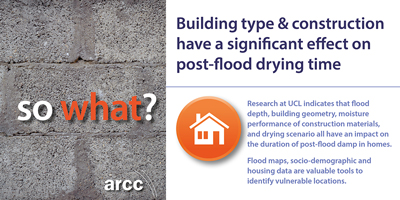Researchers at UCL found that the type and construction of a building may significantly alter its ability to dry following a flood. Flood depth and drying conditions also have an impact on the duration of damp.
This study modelled the rate of post-flood drying of London dwellings, looking at the role of housing type, flood depth, and drying conditions. High levels of ventilation and heat significantly accelerate drying, while homes with reduced ventilation and modern fibre-glass insulated cavity walls take longer to dry.
Relevance
As the climate changes, London is expected to face more frequent heavy rainfall leading to fluvial and surface floods, while storm frequency and rising sea levels may increase the risk of tidal flooding from the Thames. Dense development and a lack of drainage capacity further compound flood risk.
Vulnerable buildings and populations can be identified using flood-risk maps, e.g. from the Environment Agency. However, these maps only tell part of the story, with variations in flood depth, housing stock, and occupant socio-demographic status all influencing long-term health impacts from indoor damp, displacement, or subsequent mental health problems.
Using the duration of mould growth inside dwellings as a measure of a building’s drying potential, the study used building physics models to estimate the relative drying performance of typical London houses. The results were combined with flood maps, population data, and a building stock model to predict areas of flood vulnerability.
Findings
- Slow-to-dry materials support longer survival of hazardous bacteria
- Flats and modern airtight dwellings take longer to dry than older, more draughty houses.
- Modern houses with walls of aerated concrete bricks or glass-fibre cavity wall insulation take longer to dry.
- Forced drying can rapidly return a dwelling to normal moisture levels.
- Dwellings without any drying remain at risk of mould growth for years.
- Specific locations, such as those in East London, are at risk due to housing typology, flood risk, and population vulnerability.
Now what?
Planning for the long-term consequences of floods should take into account the vulnerability of occupants and the housing that they inhabit.
Living in a damp, flooded home presents a number of physical and mental health risks.
Current flood responses focus on short-term emergency reaction, and prioritising remediation of commercial properties. We need to increase awareness of the long-term health consequences of indoor damp or population displacement from flooded homes. Construction or retrofit of housing in flood risk areas must incorporate flood resilience into the design.
Residents and homeowners
- Do not use materials that retain moisture, e.g. glass fibre, in flood-risk areas.
- If possible, do not remain in a flooded house; at the minimum, ensure there is suitable ventilation and heating.
- Walls and floors may appear to be dry but still have a wet core; drying should continue until the room is completely dry to prevent damp returning.
Policymakers / insurance
- Prioritise remediation and support in areas where the population and housing is most vulnerable.
- Respond rapidly with remediation or alternative accommodation to prevent people from staying in flooded dwellings.
- Ensure developers use flood-resilient designs and materials in flood-prone locations.


